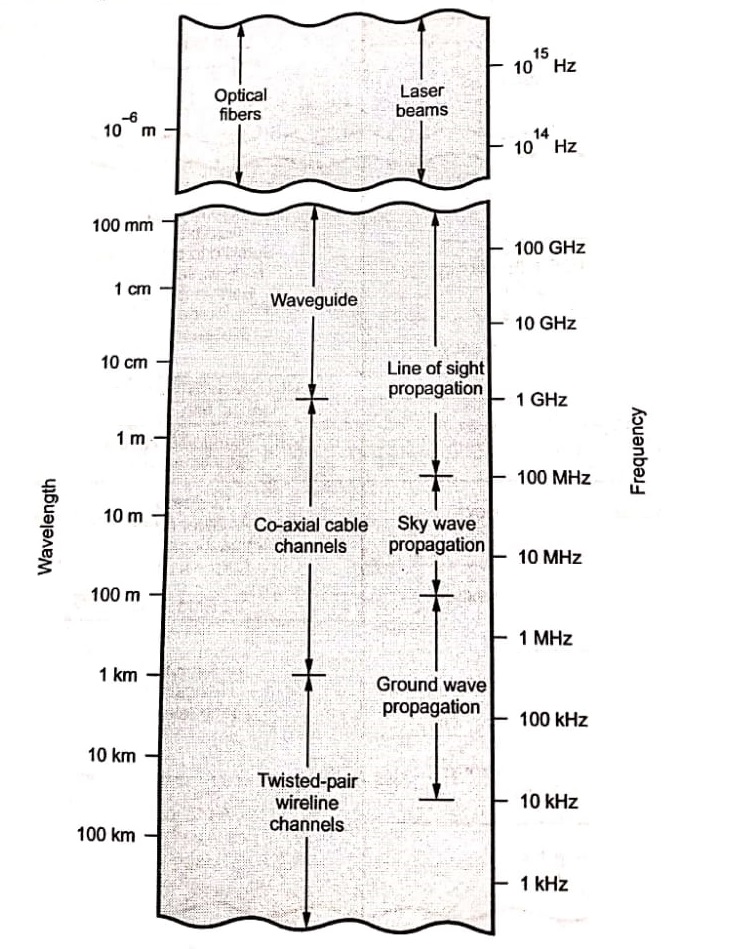We know that electromagnetic waves have two fields. One field is electric field and other is magnetic at 90°. The direction of propagation of those waves is perpendicular to both electric and magnetic fields. The electromagnetic waves travel at the speed of light (3 x 108m/sec). They can travel on electric conductors, in air, in light or in vacuum. Therefore high frequency electromagnetic waves are used as carriers for electric signals. (actually speaking, electric signals and light are also electromagnetic waves). The electromagnetic spectrum ranges from very very low frequencies to very very high frequencies. Fig shows the electromagnetic spectrum and its applications.
Fiber Optic Communication :
As shown in Fig as carrier frequency goes on increasing the transmission medium, propagation mode and applications change. Communication through optical fibers takes place at Ultraviolet, Infrared and Visible light frequenies. This is called optical communication and it is used for wide band data. Normally the transmitter or modulator in fibre optic communication system is the light source such as Light Emitting Diode (LED) or Laser beam. The intensity of the light beam is modulated by the message signal. At the receiver, the photodiode (detector) detects the varying light intensity and generates the message signal. The fiber optic communication has advantages such as wide bandwidth, low signal attenuation and reduced noise
interference.
Wireline Communication :
The telephone network which we are using presently is an example of wireline communication. Normally wire pairs or coaxial cables are used for this purpose. The signals in audio, very low and low frequency range are carried on wire pair. The bandwidth of wire pairs is limited upto 300kHz. The coaxial cables give comparatively larger bandwidth i.e. upto 14Hz. The cable television which we see today is on the co-axial cable only, and they use TV channels in the UHF and VHF range. Fig illustrates the frequency ranges of wireline, wireless and fiber optic communications.

Wireless Communication :
As the name indicates, there is no wire or any such medium for conduction of electromagnetic waves. Wireless communication takes place through air or vacuum. The frequencies right from 10kHz upto 100GHz are transmitted using wireless communication. Electromagnetic waves can be transmitted either by ground wave propagation, sky wave propagation or line of sight propagation depending upon the frequency.
Fig shows different frequency ranges and their modes of propagation. All the radio, TV and satellite broadcasting is wireless communication. In wireless communication, the electromagnetic waves are transmitted and received with the help of radiators or antennas. The size of such radiations or antennas depend upon the frequency being transmitted/received. Normally for efficient radiation of the electromagnetic energy, the length of the antenna must be at least 1/10 of the wavelength of frequency being transmitted. For example consider the case of AM radio station transmitting 1MHz frequency. The wavelength of this frequency is,
![]()
Length of the transmitting antenna ![]() at least.
at least.
The size of the antenna will reduce if the frequency of transmission is increased. Because of this reason, wireless communication is not used for low frequencies. The advantages of wireless communications are cost effectiveness, possible long distance communication and simplicity. But the drawbacks are noise interference, environmental effects and attenuation of the signal.
Wireline communication and wireless communication can both be used for some frequency range. The choice is made upon the required distance and coverage area.
| Read More Topics |
| Optical Receiver Operation |
| Radio over fiber link |
| Optical fiber communication |






